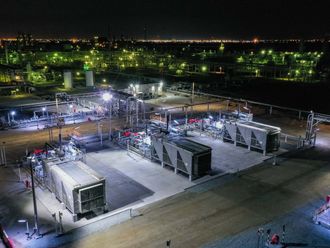London: Brent crude rose above $108 per barrel on Tuesday, supported by clashes across Ukraine and lingering uncertainty over Libya’s supply recovery.
Pro-Russia rebels shot down a Ukrainian helicopter in fierce fighting near the eastern town of Slaviansk, while Kiev moved police special forces to the port city of Odessa to stop the rebellion spreading westward.
And in Libya, the vital southern El Sharara oilfield remains closed while new protests shut the Zultun and Raquba oilfields in the central eastern region of the OPEC producer. Oil output totals just 250,000 barrels per day.
“This shows once again just how difficult and stony the path towards normalising oil production in Libya really is,” said Carsten Fritsch of Commerzbank.
“The Brent price should remain supported as a result. The escalation of the situation in east Ukraine also points to a price recovery.” Brent crude climbed 37 cents to $108.09 per barrel by 0914 GMT. US oil was up 27 cents at $99.75.
RISING US STOCKS Oil’s gains are being capped by plentiful supplies in top consumer the United States, with commercial crude inventories forecast to have hit a record high for a third straight week due to higher imports.
The American Petroleum Institute (API), an industry group, is due to issue its weekly inventory report at 2030 GMT, while the US Department of Energy’s Energy Information Administration (EIA) will issue its report on Wednesday.
A preliminary Reuters poll of five analysts, taken ahead of the reports, showed expectations centring around a rise of 1.5 million barrels in crude oil stocks for the week ended May 2.
EIA data wiped off nearly 2 per cent from US oil futures over two days last week by showing US crude stocks hit a record high in the week to April 25, led by another steep increase on the Gulf Coast.
However, in Cushing, Oklahoma, the delivery point of WTI crude, crude stocks have dropped in the last three weeks, as new infrastructure relieves recent bottlenecks at the key oil hub.
“A 1.5 million barrel draw per week could put Cushing two-three weeks away from reaching tank bottoms,” Morgan Stanley said in a research note.
“If realised, the benefit for WTI prices and differentials may be modest from here, but backwardation at the front end of the WTI curve should steepen.”












